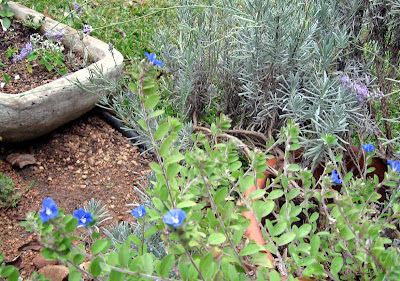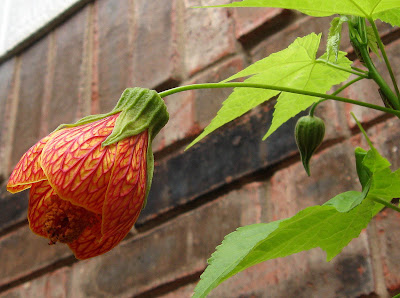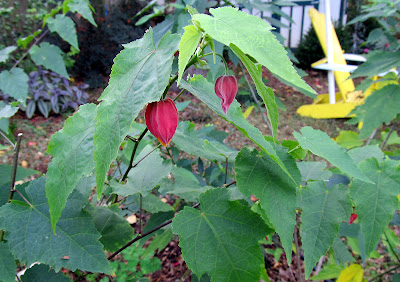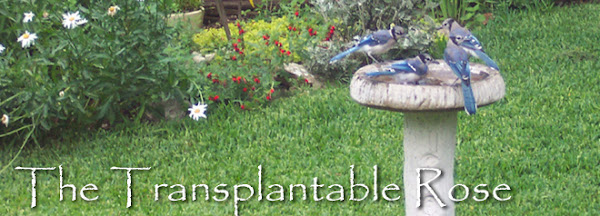The monthly recording by Garden Bloggers of what's in bloom in our yards was
started by May Dreams Carol in February 2007. It became an instant tradition, letting us share our garden flowers while acting as a useful tool to keep track of how the plants we grow act in different years.
Many dependable plants will make a fourth appearance in this November GBBD post. But there are downsides to keeping records... a glance back shows what is
not here - cold January 2010 weather killed the Duranta, defeated the Confederate Rose and disappeared every bit of the yellow bulbine, a plant that had grown so exuberantly in 2009 it was thinned and divisions were given away.
With records to tell me what to expect, should I now feel cheated because the usual November bloomers didn't flower? Woe, woe, for the spindly Passion vine, the struggling Brugmansia and what remains of the Toad lily! The roses are 'resting' and the Sweet Olives are off schedule. There is not one Meyer's lemon for Thanksgiving cranberry relish? No fair!

Enough of the whining - one advantage of being a plantaholic is that no matter how many plants bail on bloom day - something will have flowers:
It's ironic to see the
Camellia 'Shishi Gashira', beautifully budded and with glossy foliage after a year that knocked off plants more suited to Central Texas.

The Loquat tree is also well-budded, now opening the first flowers - so even without the Sweet Olive's fragrance, November smells sweet.

Just a breeze across the leaves can make the Pineapple sage release scent, too. One plant grows in the Hummingbird bed.. this one is near the Blue Butterfly Clerodendron on the patio. Pineapple sage seldom lives through winter but it's usually easy to find starts in spring. Replacements for blue Clerodendron are hard to find and expensive. After helping me find this large potted Blue Butterfly,
Robin told me that cuttings root easily. I've taken her advice and have rooted a few pieces to grow indoors as insurance that blue butterflies will float over my garden next year.
 Salvia regla
Salvia regla would prefer life on a rocky hillside in the Chisos Mountains of Big Bend, but it survived the 12" deluge from Hermine in September and has been popping orange flowers for weeks. Most sites call it a shrub, but it freezes back so hard in my garden that it never attains much size.

More orange and yellow come from Tropical Milkweed/
Asclepias curassavica and Mexican Mint Marigold. The milkweed doesn't always survive winter but usually reseeds somewhere nearby. The Mexican Mint marigold/
Tagetes lucida, has been perennial in my garden since 2004.

A paler yellow color comes from the
Salvia madrensis/Forsythia sage, seen here leaning onto the Mexican Honeysuckle/
Justicia spicigera
I've grown Moon Flower vine/
Ipomoea alba for decades but don't remember buds and flowers in mid-November - they look defiant against yesterday's grey afternoon sky

Because two plants of
Ageratina havanensis survive & bloom in the front yard, a third plant of the native fragrant mistflower went into the yaupon bed this spring, mingling with Salvia vanhouttei. The salvia is pretty tender but the mistflower should return.

The pink gaura looked horrible in late summer... a severe pruning and cooler weather produced intensely colored flowers

The pot of 'Provence' lavender started blooming in May and hasn't given up. Neither has the Evolvolus 'Blue Daze'. These plants don't do well when planted in my clay soil but they can do well in containers

If we can avoid a freeze for a few more weeks, these tiny peppers might make it to the kitchen.

All the above blooms have made previous November appearances - but this is the first November for some new plants.
'Marilyn's Choice' Abutilon was a 1-ft tall rooted cutting when I planted in the new yaupon bed last spring. It made a few flowers, then turned to branching and growing into a gawky shrub. This abutilon looked like a big weed all summer, not reblooming until now. The flowers are not thrilling me but watching them develop is interesting.

I planted another plant in the mallow family, Pam's Pink Turkscap/
Malvaviscus 'Pam Puryear' in the same bed. It also grew into a large, gawky, branched plant that looked like a weed as summer waned. It had a few pink flowers at the beginning of November but they're gone for GBBD.
After planting the 'Marilyn's Choice', I hedged my bets by moving the other small abutilon into a container so at least one of them could be taken in or covered in cold weather. The second abutilon was just called 'Patrick's', but
Linda of the Central Texas Gardener TV show let me know it's named after Central Texas garden designer Patrick Kirwin. This plant never branched but steadily produced one lovely flower at a time on an ever-taller stalk.

The Shrimp plant/
Justicia brandegeana was planted in late spring. It opened a few flowers, then looked stressed. Apparently what it wanted was relocation! Instead of trusting the gardener to catch on the Shrimp plant grew an elongated stalk, leaned that stalk onto the ground, rooted it at the end and sent up a healthier plant 2-feet away from the spot I'd chosen. The flowers do look like seafood, don't they?

Lion's Tail is another new plant that resented being planted this year, not growing at all for months. After Hermine is perked up, grew steadily and now has buds. But we're getting close to average frost date and it's only borderline hardy in my part of Austin - any bets on whether these buds will open before the plant freezes?

A final November bow by a newcomer is made by the miniature climbing rose 'Red Cascade' rose, described as a miniature climbing rose. It wasn't planted until midsummer and I don't know how it will do longterm, but how good it is to see in bloom on this November day.

For a bloom-tour around the world go to
Carol's November GBBD Roundup.
For my list of everything that has a flower, with my best tries at botanical names, go to
Annie's Addendum

 The buds began to form on the abutilon almost as soon as the first leaves fell from the pecan tree, which may be a sign that its spot is too shady.
The buds began to form on the abutilon almost as soon as the first leaves fell from the pecan tree, which may be a sign that its spot is too shady.



























